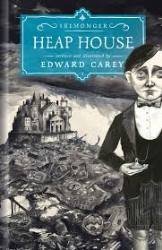Heap House by E. Carey
DOI:
https://doi.org/10.20361/G2MP4NAbstract
Carey, Edward. Heap House. Toronto: Harper Collins Publishers Ltd, 2013. Print.
This Young Adult gothic mystery novel tells the story of the Iremonger House, also known as Heap House, and its inhabitants Clod Iremonger and Lucy Pennant. The book contains Victorian themes and imagery, and also deals with supernatural elements.
Clod Iremonger belongs to one of the most powerful families in England. The Iremongers made their fortune by gathering the trash of other people in London. All of this trash has combined to create the giant, toxic sea known as the Heaps. At the centre of the Heaps is the gigantic Iremonger house, made up of a combination of other houses and castles. The Iremongers live in Heap House.
Although the Iremongers are very rich, they are also very reclusive, strict, and cruel. Clod’s grandfather rules over the clan, determining their futures, from career to marriage. A large host of servants run the household, known simply as Iremongers. These servants are distant relatives of the Iremonger clan, and lose all identity when they enter service. The Iremongers, servant and family alike, all share one other strange peculiarity - each member is presented with an object upon birth, which must be kept on their persons at all times. These objects could be anything - from a mantlepiece to a bath plug. Clod is about to turn sixteen, and become a man. However, Clod is also special. A sickly child, he has always been able to hear objects talking - each repeating a unique name, over and over. When his Aunt’s birth object goes missing, and a new servant girl named Lucy Pennant enters the household, Clod’s entire world begins to change. With the help of kindred spirit Lucy, Clod begins to uncover the mysteries of his family, and why he can hear objects speak. He also begins to find his own independence.
Heap House is definitely a novel for older readers. The book alternates between the viewpoint of Clod and Lucy. The world set-up is slow to unfold, and complicated, which could leave readers initially confused. Some interactions and descriptions are quite drawn out, and the mystery may not be compelling enough to encourage further reading. The novel also deals with complex issues of social class, sickness, death, corruption, bullying, abuse, incest, environmental destruction, and loss of identity. Edward Carey, the author, has also provided illustrations for readers, in between each chapter. Although this can be helpful in visualizing Heap House itself, it could also be distracting for older readers who do not need visual aids to interpret the story. The novel does not end neatly either, which could frustrate readers at the lack of resolution to introduced stories and characters. The intricacies of the novel, however, do make it a very unique read, full of Victorian imagery and evocative of industrial London.
The novel is part of a trilogy, including the sequel Foulsham, and a yet un-named title. The author’s website also features an interactive exploration of the setting of released novels.
Recommended: 3 out of 4 stars
Reviewer: Colette Leung
Colette Leung is a graduate student at the University of Alberta, working in the fields of Library and Information science and Humanities Computing who loves reading, cats, and tea. Her research interests focus around how digital tools can be used to explore fields such as literature, language, and history in new and innovative ways.

Published
How to Cite
Issue
Section
License
Authors who publish with this journal agree to the following terms:
- Authors retain copyright and grant the journal right of first publication with the work simultaneously licensed under a Creative Commons Attribution License that allows others to share the work with an acknowledgement of the work's authorship and initial publication in this journal.
- Authors are able to enter into separate, additional contractual arrangements for the non-exclusive distribution of the journal's published version of the work (e.g., post it to an institutional repository or publish it in a book), with an acknowledgement of its initial publication in this journal.
- Authors are permitted and encouraged to post their work online (e.g., in institutional repositories or on their website) prior to and during the submission process, as it can lead to productive exchanges, as well as earlier and greater citation of published work (See The Effect of Open Access).






